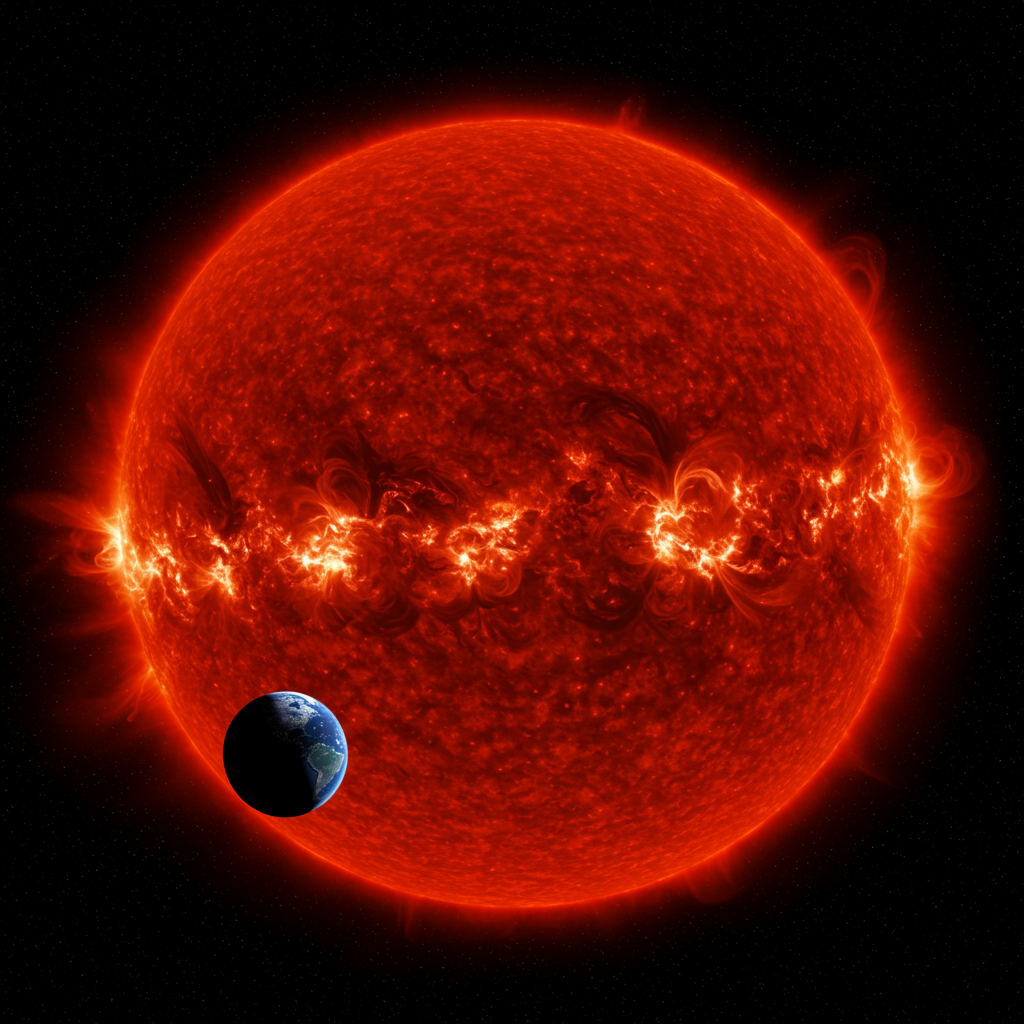The future is almost impossibly bright for our corner of the galaxy—perhaps too bright for life as we know it. For billions of years, our Sun has been a stable source of light and warmth, providing the perfect conditions for life to emerge and thrive on Earth. Yet, this era of cosmic calm is finite. Our star is aging, and its inevitable transformation promises a dramatic and devastating end for the inner solar system.
The sun’s Engine and Its Finite Fuel
Right now, our Sun exists in its most stable phase, a period astronomers call the main sequence. It’s a G-type yellow dwarf star powered by nuclear fusion at its core. Deep within the Sun’s heart, immense pressure and temperature force hydrogen atoms together, creating helium. This process converts about 700 million tons of hydrogen into 695 million tons of helium every single second. The missing five million tons of mass doesn’t disappear; it’s converted into pure energy, following Einstein’s famous equation, E=mc².
This incredible energy output—a staggering 4 x 10²⁶ watts—radiates outward, providing the light and heat essential for Earth’s climate. Only a tiny fraction, about half a billionth, of this energy reaches our planet, yet it’s precisely the right amount to maintain our delicate balance. Earth’s distance from the Sun, its atmosphere, and its reflectivity all play a role in keeping our world habitable. The greenhouse effect from natural gases helps trap enough heat to keep the average temperature well above freezing.
Slow, Inexorable Change
While the Sun appears constant from day to day, over millions and billions of years, its internal processes cause profound changes. The helium produced by fusion in the core is like ash; it doesn’t participate in the fusion reaction. This helium “ash” builds up at the Sun’s center. As more helium accumulates, its sheer mass compresses the core even further. Compressing a gas generates heat, and this slow, steady heating of the core causes the Sun’s fusion rate to gradually increase.
This increased fusion rate means the Sun becomes slightly more luminous over time. This isn’t a rapid change. It happens over hundreds of millions of years, but the cumulative effect is significant. Running the cosmic clock forward an eon or two reveals the initial stages of disaster for Earth.
The Beginning of the End: Losing Earth’s Oceans
As the Sun grows brighter, Earth’s temperature will climb inexorably. Eventually, temperatures will become high enough to cause a runaway greenhouse effect. Our planet’s surface water will begin to evaporate at an accelerated rate, turning into water vapor. Water vapor is a powerful greenhouse gas, trapping even more heat and accelerating the process.
Within perhaps a billion years, the Earth’s atmosphere will be thick with steam, and eventually, all the surface water will boil away. The oceans will be gone. This global desiccation marks the definitive end of life as we know it on Earth. Even before the Sun reaches its dramatic red giant phase, rising ultraviolet radiation and solar wind particles could strip away much of Earth’s upper atmosphere, potentially losing light hydrogen atoms and most of our water within a billion years, making Earth resemble a parched, Mars-like world.
The Red Giant Transformation
The processes in the Sun’s core become more complex after the hydrogen fuel there is exhausted. Fusion will cease in the very center, but a shell of hydrogen fusion will ignite around the now inert helium core. This shell burning releases a tremendous amount of energy, much more than the old core fusion did. This excess energy is dumped into the Sun’s outer layers, causing them to expand dramatically. When you heat a gas, it expands, and the Sun’s outer envelope will balloon to enormous proportions.
The Sun will swell to become a red giant star. Estimates suggest it could expand to be 100 to 200 times wider than it is today. While its surface temperature will cool slightly, giving it a ruddier appearance, its total energy output will be vastly higher, possibly radiating energy up to 2,400 times stronger than now. This red giant phase is expected to last for about a billion years.
A Fiery Demise for Inner Worlds
The sheer scale of the red giant Sun is almost impossible to comprehend. It will be so vast that it will definitely engulf the orbits of the innermost planets, Mercury and Venus. These worlds will be consumed and vaporized by the Sun’s expanding outer layers.
The fate of Earth is a subject of debate among astronomers. Some models suggest the Sun’s outer edge will expand just beyond Earth’s current orbit, while others indicate it will fully engulf our planet. Regardless of whether the surface physically reaches Earth, the conditions will be catastrophic.
Earth’s Hellish Future (Even If Not Engulfed)
Even if Earth somehow avoids being physically consumed by the expanding red giant, it will become utterly uninhabitable. The intense luminosity from the much brighter star will raise Earth’s surface temperature dramatically. Temperatures could reach around 1,300 degrees Celsius, hot enough to melt lead. The surface rocks would melt, turning our world into a lava planet during the day.
The superheated atmosphere would be stripped away by the intense stellar wind and the extreme temperatures. Any remaining water would be instantly vaporized and blown into space. Earth would be left as a barren, molten cinder orbiting the bloated red star.
Outward Migration: A False Hope?
As the Sun expands into a red giant, it undergoes significant mass loss. Its solar wind becomes much more powerful, ejecting vast amounts of material into space. This mass loss weakens the Sun’s gravitational pull. According to Kepler’s laws of planetary motion, a weaker central gravity means orbiting planets will drift outward.
The planets of our solar system will indeed migrate to larger orbits. However, for the inner planets, this outward drift is unlikely to be enough to save them from the expanding solar furnace. Mercury and Venus are doomed regardless. For Earth, while the outward migration slightly increases its chances of avoiding physical engulfment, it doesn’t prevent the world from becoming molten.
The Fate of the Outer Solar System
What about the gas giants and icy worlds further out? Jupiter, currently a frigid world with an average temperature of -110 degrees Celsius, will heat up considerably. Its temperature could rise to over 300 degrees Celsius. Its large icy moons, many of which hold subsurface oceans and are considered potential abodes for life today, will melt and begin to boil away. Saturn, Uranus, and Neptune will also warm significantly.
The enhanced mass loss and strong stellar winds, particularly during later, hotter phases (like the brief pre-white dwarf stage with winds over 2000 km/s), will likely strip away the outer atmospheric layers of the gas giants. Detailed calculations are still needed, but they might survive as mere “ghosts” of their former, majestic selves.
A Brief, Chilly Respite on Pluto?
In this far-future solar system dominated by a red giant, the only place potentially offering even a marginally clement climate might be the dwarf planet Pluto. At that time, Pluto will have migrated to an even greater distance from the Sun, perhaps 50 times farther than Earth is now. Its surface temperature might hover around -10 degrees Celsius.
While still very cold, this temperature is relatively warm compared to Pluto’s current deep freeze. If there’s enough frozen methane and carbon dioxide on Pluto, these ices could vaporize and create a thin atmosphere. This atmosphere could potentially provide just enough greenhouse warming to make the tiny world temporarily somewhat comfortable, although likely not truly habitable for complex life. This potential reprieve would be fleeting.
The Final Stage: White Dwarf and Cosmic Chill
The red giant phase lasts for about a billion years. Eventually, the Sun will exhaust the helium fuel in its core (which fuses into carbon and oxygen). It will then undergo a final, dramatic transformation. The Sun will eject its outer layers into space, forming a beautiful but short-lived structure called a planetary nebula. What remains is the Sun’s core.
This core will collapse under gravity, shrinking to an incredibly dense object about the size of Earth. This is a white dwarf. A white dwarf is essentially a dead star; it has exhausted its nuclear fuel and no longer generates energy through fusion. It will be incredibly hot initially, but because it’s so small, it radiates very little heat into space. Over vast timescales—trillions of years—the white dwarf will slowly cool and fade, eventually becoming a cold, dark cinder known as a black dwarf (though the universe isn’t old enough for any black dwarfs to exist yet).
The Deep Freeze Returns
Once the Sun becomes a white dwarf, its heat output will be negligible. The planets, having drifted outward but still bound to the dead star’s gravity, will cool down once again. They will plummet far below the freezing point of any biologically useful molecules, becoming frozen, dark, inert bodies in the dim light of the white dwarf.
This journey from stable star to red giant to white dwarf is the typical fate for stars like our Sun. Unlike much more massive stars (8-10 times the Sun’s mass or more), our Sun does not have enough mass to fuse heavier elements up to iron, which triggers a core collapse and a spectacular supernova explosion, potentially leaving behind a neutron star or black hole. Our Sun’s end is quieter, though no less devastating for its planetary system.
Looking Billions of Years Ahead
It’s crucial to remember that all of these dramatic events are billions of years in the future. Our Sun is currently about 4.5 billion years old and has roughly 5 billion years of stable main-sequence life remaining. The complete destruction of Earth wouldn’t occur for at least another billion years after that, during the red giant phase.
The timescale of human civilization is tiny compared to these cosmic epochs. We don’t know what humanity will look like, or if we will even still exist, billions of years from now. If we do, perhaps we will have mastered interstellar travel, capable of finding new homes around younger, more stable stars. The universe is vast, with countless stars being born all the time, many likely with their own planets. While leaving one’s home is never ideal, facing an uninhabitable planet offers little other choice. Future generations, if they exist, may need to pack up and find another Earth to settle down on before that star, too, begins its inevitable journey towards the end of its life.
Frequently Asked Questions
What causes the Sun to become a Red Giant?
The Sun transforms into a red giant when it exhausts the hydrogen fuel in its core. The core contracts, and a shell of hydrogen fusion ignites around it. This shell burning is much more intense, generating excess energy. This energy flows outward, causing the Sun’s outer layers of gas to expand dramatically, swelling the star to many times its original size.
Which planets might offer a temporary refuge from the Sun’s Red Giant phase?
Within our solar system, the dwarf planet Pluto is speculated as a potential location for a temporary, marginally clement climate during the Sun’s red giant phase. Because it will have migrated much farther out (around 50 times Earth’s distance) and potentially has sufficient frozen methane and carbon dioxide to form a thin, warming atmosphere, its surface temperature might rise to around -10 degrees Celsius, making it relatively warmer than its current state.
Should humanity be concerned about the Sun becoming a Red Giant?
From a practical, immediate standpoint, no, humanity should not be concerned about the Sun becoming a red giant. These catastrophic events are billions of years in the future. The Sun is expected to remain stable for another 5 billion years. Human civilization and likely human existence on Earth will face countless other challenges or have undergone unimaginable transformations long before our star reaches the end of its stable life.




